|
|
News items from 2016 on the 'Pocklington and District Local History Group' website.
Back to Latest News |
|
| |
|
| WW1 - The battle of the Somme |
| 10th November 2016 |
|
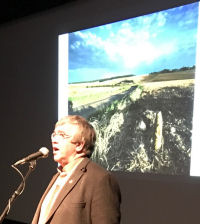 Phil Gilbank, chairman of The Pocklington & District Local History Group introduced the commemoration of events of a hundred years ago with a World War One talk and exhibition in Pocklington Arts Centre that focussed on the tragedies and heroics of local men from across the district during the Somme offensive of 1916. Gareth Hughes, head of history at Pocklington School and the author of a guidebook to the WWI battlefields, gave a talk entitled ‘The Somme: futile tragedy or birthplace of victory?’. Hughes is a noted expert on the Somme and has taken numerous parties of schoolchildren on visits to the battlefields. The evening also heard ‘Voices from the Past’, short recordings and readings of local men who served in the trenches. Andrew Sefton had re-edited some of the recordings of soldiers from Pocklington and surrounding villages recalling their experiences; while David Rumbelow read some extracts from a diary by John Brooke who fought throughout the conflict. Brooke was a Pocklington plumber when he joined the 5th Yorkshire (Green Howard) Territorials in August 1914. He was sent to France in April 1915 and was plunged straight into the battle of Ypres. Keeping a diary at the front was prohibit 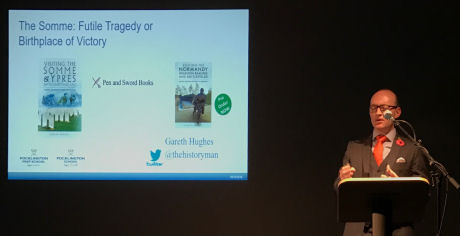 ed in case it fell into enemy hands, but Brooke had a remarkable memory for detail and wrote a retrospective log of his wartime experiences, including life in the trenches and in no-mans land at the Somme and meeting up with friends from back home. He was still at the front when the war ended in November 1918, being repatriated and returning to Pocklington to start up in business again in The Pavement in early 1919. Paul Bennett, the bursar and clerk to the governors at Pocklington School, read from another unique account of fighting in the trenches. Bennett went to see the Imperial War Museum WWI exhibition in London in 2014. He purchased an exhibition brochure, written by leading author, Sebastian Faulks, of ‘Birdsong’ fame, and was amazed to find the brochure prominently featured a letter to one of his predecessors as clerk, local solicitor, Alfred Summerson. The letter was sent back to Pocklington by a soldier called ‘Harry’, but attempts to discover his full identity have not yet succeeded. 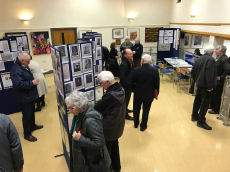
To coincide with the evening was a World War One exhibition of photographs, memorabilia, newspaper articles and stories from across the district open from Thursday 10 November to Tuesday 15 November in the Arts Centre studio. |
| |
| George Hudson, The Railway King |
| 21st October 2016 |
|
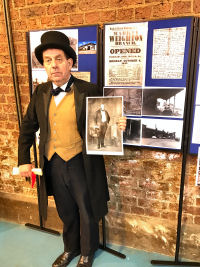 George Hudson walked into Pocklington Station in 1847 to review his newly opened railway station. The railway line was laid between Market Weighton and York for the transportation of goods and passengers. Historical actor Chris Cade gave a very entertaining talk and presentation of the life of George Hudson 'The Railway King', dressed in costume and acted out with audience participation how George had started from humble roots to become and amazing entrepreneur who created many of the north's railway network and stations, only to fall in later life in debtors prison with many people losing t George Hudson walked into Pocklington Station in 1847 to review his newly opened railway station. The railway line was laid between Market Weighton and York for the transportation of goods and passengers. Historical actor Chris Cade gave a very entertaining talk and presentation of the life of George Hudson 'The Railway King', dressed in costume and acted out with audience participation how George had started from humble roots to become and amazing entrepreneur who created many of the north's railway network and stations, only to fall in later life in debtors prison with many people losing t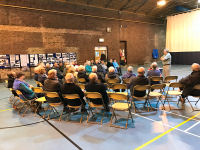 heir money by buying his shares in the railway companies and for them to eventually become worthless pieces of paper. It was appropriate for the presentation to be held in the Sports Hall which is a lucky surviving remnant of the old railway line, whereas the old station at Market Weighton was demolished and now a housing estate. Pocklington station gained a second life as the sports hall for Pocklington school. An exhibition of old photographs was put on display and were moved to the Oak House Arts Centre for a weeks further display. heir money by buying his shares in the railway companies and for them to eventually become worthless pieces of paper. It was appropriate for the presentation to be held in the Sports Hall which is a lucky surviving remnant of the old railway line, whereas the old station at Market Weighton was demolished and now a housing estate. Pocklington station gained a second life as the sports hall for Pocklington school. An exhibition of old photographs was put on display and were moved to the Oak House Arts Centre for a weeks further display.
|
| |
| A little bit of Pocklington in Detroit |
| 22nd September 2016 |
|
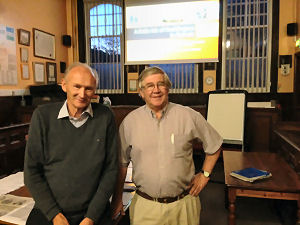 John Kent from Surrey has researched his wife's ancestors (the Lamb family) and discovered a group of around 40 adults from Pocklington and district who emigrated to near Detroit in Michigan, USA in the nineteenth century. He researched them and has produced much information on the emigrants. It included the families of Lee, Vaux, Lamb, Walker, Ackley, Houghton, Hunt and Watson. They arrived in the period between 1830 - 1845 and by 1860 there were more than 40 adults and 50 children from the Pocklington area that settled in 'Leesville', Detroit, so named after Charles "father" Lee from Pocklington. Phil Gilbank gave a superbly delivered talk on the families, reasons for emigration, the place where they emigrated to, and the difficulites they encountered. The skills they brought with them were very useful and included farming, wheelwrighting, blacksmithing, brick making, all very useful skills in the new world and the settlers and their offspring soon prospered. Their settlement of Leesville became swallowed up as a suberb of Detroit as the city rapidly expanded. A publication is being considered to bring this research together and publish the findings. John Kent from Surrey has researched his wife's ancestors (the Lamb family) and discovered a group of around 40 adults from Pocklington and district who emigrated to near Detroit in Michigan, USA in the nineteenth century. He researched them and has produced much information on the emigrants. It included the families of Lee, Vaux, Lamb, Walker, Ackley, Houghton, Hunt and Watson. They arrived in the period between 1830 - 1845 and by 1860 there were more than 40 adults and 50 children from the Pocklington area that settled in 'Leesville', Detroit, so named after Charles "father" Lee from Pocklington. Phil Gilbank gave a superbly delivered talk on the families, reasons for emigration, the place where they emigrated to, and the difficulites they encountered. The skills they brought with them were very useful and included farming, wheelwrighting, blacksmithing, brick making, all very useful skills in the new world and the settlers and their offspring soon prospered. Their settlement of Leesville became swallowed up as a suberb of Detroit as the city rapidly expanded. A publication is being considered to bring this research together and publish the findings.
|
| |
| Pocklington Church stone |
| 16th July 2016 |
|
 300px.jpg) Richard Myerscough is an expert in origin of church stone, and gave us a church tour explaining about which pieces of stone were Birdsall Calcarious Grit, Redcar Mudstone, Late Jurassic Hildonley Limestone and which pieces were most likely robbed from other buildings in the area. The high status and rare Hildonley was also used by the Romans and Monastary buildings. Richard pointed out stones in the wall of likely Roman origin and the remarkable amount of stone in the floor of the church which was of high status Hildonley. The large numbers of repairs and rebuilding evidence were found over all sections of the outer walls. Magnesium Limestone from West Yorkshire was also found in the Eastern end wall of the church. A very fascinating tour of the church, which opened up many possibilities for further research. A good attendance in association with the Friends of Pocklington Church with all proceeds given to the church funds. Richard Myerscough is an expert in origin of church stone, and gave us a church tour explaining about which pieces of stone were Birdsall Calcarious Grit, Redcar Mudstone, Late Jurassic Hildonley Limestone and which pieces were most likely robbed from other buildings in the area. The high status and rare Hildonley was also used by the Romans and Monastary buildings. Richard pointed out stones in the wall of likely Roman origin and the remarkable amount of stone in the floor of the church which was of high status Hildonley. The large numbers of repairs and rebuilding evidence were found over all sections of the outer walls. Magnesium Limestone from West Yorkshire was also found in the Eastern end wall of the church. A very fascinating tour of the church, which opened up many possibilities for further research. A good attendance in association with the Friends of Pocklington Church with all proceeds given to the church funds.
|
| |
| A walk around Nunburnholme |
| 24th June 2016 |
|
|
| |
| Harry Hughes - "One of the Many " |
| 8th May 2016 |
|
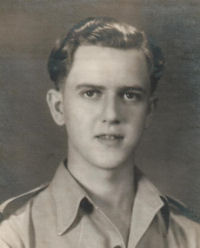 Harry Hughes DFC DFM AE and Bar FICS. Harry Hughes DFC DFM AE and Bar FICS. " One Of The Many - A navigator in 102 (Ceylon) Squadron at Pocklington and Pathfinders".
Harry gave a very entertaining presentation with his recollections of being a navigator in the crew of a Halifax Bomber flying out of Pocklington Airfield. He was assisted by Simon Whittaker who asked the questions. Harry trained in North America and became a navigator aboard the Halifax bomber and arrived at Pocklington in February 1943. At this time the 102 Squadron was suffering some of the heaviest casualties of the war within the whole RAF. He was in Pocklington for 6 months and finished his tour. Then after a period of instructing he returned to operations with 8 Group Pathfinders on 692 Squadron, which was part of the Light Night Striking Force . They were based across the A1 from Bedford at Gravely. 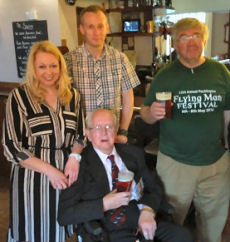 On their Mosquito aircraft they carried a 4000lb bomb with just 2 crew, mainly to Berlin. Harry mentioned his affection for Pocklington and said on his nights off he would go for a drink or two in the Station Hotel. He said he always liked to return to Pocklington as he got such a warm welcome. After the talk Harry left the church and went across the road to enjoy his first pint there for over 60 years!
Left: Harry enjoys a pint in the Station Hotel, his first there since 1943!
Phil Gilbank toasts Harry along with Harry's helper and talk assistants Simon Whittaker and Dawn Duffield.
 Read more about Harry's life in his book " Five of the Many" by Steve Darlow. Survivors of the Bomber Command Offensive from the Battle of Britain to Victory tell their story. This book follows the experiences of five of RAF Bomber Command’s airmen including Wellington pilot Rupert Cooling, Wellington and Mosquito pilot Jack Goodman, Halifax pilot Joe Petrie-Andrews, Lancaster pilot Tony Iveson and 102 Squadron’s Halifax and Mosquito navigator Harry Hughes.
Publisher: Grub Street Publishing; (31 Oct 2007)
ISBN-10: 1904943985
ISBN-13: 978-1904943983
|
| |
| Flying Man celebrations 2016 |
| 7th/8th May 2016 |
|
|
|
|
The History Group display |
|
|
Simon Kularatne and Bernard Ross near Bernard's model of Pocklington Airfield |
The history group display with the Flying Man entry in the Parish Register |
|
|
The display of the Halifax bomber engine, later started up on West Green |
A busy morning in the Flying Man cafe |
| |
|
| The AGM |
| 21st April 2016 |
|
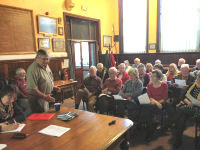 Phil opened the 2016 AGM holding the newly printed programme for the 2016/17 year ahead. He was pleased with the past year from a History Group perspective and the exciting discoveries found in the Iron Age cemetery on the outskirts of the town. Treasurer Peter Green went through the finances and announced a net deficit on the year of £35 mainly caused by the purchase of a new laptop and other costs associated with purchasing items and copies of Pocklington Parish records from the Percy Archive in Alnwick. Because other sources of income were declining, such as reduced book sales, Peter made a request for a new book to be produced to boost our income, even though our accounts showed a healthy closing balance. The election of the committee followed and a proposal from the floor was made to re-elect the current committee in one vote, which was seconded and passed unanimously. Requests were made for new additions to the committee following the resignation of Heidi Woodhouse. None were forthcoming, but if anyone does wish to step forward please contact the Chairman or Secretary.
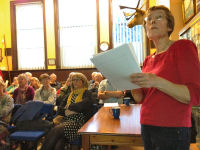 2016/17 Re-Elected Committee: Chairman 2016/17 Re-Elected Committee: Chairman - Phil Gilbank, Secretary – Jo Green, Treasurer – Peter Green, Archivist/Webmaster – Andrew Sefton, Committee – Denis Moor, David Rumbelow, Chris Bond, Paul Jennings, Jane Henley (representing the villages) and David West. Two vacancies exists for committee members. Roger Bellingham remains Honorary President. The AGM was followed by a talk by Jane Henley on the past libraries of Pocklington (see picture) and a summary by Phil Gilbank of the current status of the Burnby Lane dig and possible proposal for a permanent display of the finds at a suitable site in Pocklington. It was followed by a review of the year by Andrew Sefton. Photographs and historical finds made during the year were shown as well as a video of a Halifax engine that was fired up at the last Flying Man festival on West Green. |
| |
| The origins and history of Yorkshire dialects |
| 17th March 2016 |
|
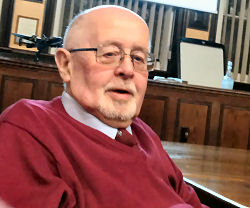 Dr Barrie M. Rhodes explained the history of the invasions of this country from the Romans through the Anglo-Saxons and the Vikings to the Normans. Parts of our present language was left by each of them: the Anglo-Saxon (Germanic) language became the basis for modern day English largely replacing, the previous Brythonic (Romanic) language spoken by the Celts. The later invasions by the Vikings left an imprint on Yorkshire, which was part of the Danelaw, and was the basis for Yorkshire dialects. Yorkshire was divided into ridings (from the Old Norse Thrydings) and many of its place names are of Scandinavian origin. The main contributors to Yorkshire dialects today are Old English and Old Norse/Old Danish together with a smaller contribution from Old (Norman) French. Barrie sees the dialects (or languages) as constantly evolving over time. He mentioned ‘the tyranny of standard English ’ which he maintains is only another dialect of English and says that the speakers of other dialects in this country should never regard their language as less valid than the standard. Barrie gave a passionate talk about his subject to an attentive and full room of listeners. His talk was full of humour and announced at 80 years of age he was retiring from public speaking and joked "I am at an age where I no longer buy green bananas!" Dr Barrie M. Rhodes explained the history of the invasions of this country from the Romans through the Anglo-Saxons and the Vikings to the Normans. Parts of our present language was left by each of them: the Anglo-Saxon (Germanic) language became the basis for modern day English largely replacing, the previous Brythonic (Romanic) language spoken by the Celts. The later invasions by the Vikings left an imprint on Yorkshire, which was part of the Danelaw, and was the basis for Yorkshire dialects. Yorkshire was divided into ridings (from the Old Norse Thrydings) and many of its place names are of Scandinavian origin. The main contributors to Yorkshire dialects today are Old English and Old Norse/Old Danish together with a smaller contribution from Old (Norman) French. Barrie sees the dialects (or languages) as constantly evolving over time. He mentioned ‘the tyranny of standard English ’ which he maintains is only another dialect of English and says that the speakers of other dialects in this country should never regard their language as less valid than the standard. Barrie gave a passionate talk about his subject to an attentive and full room of listeners. His talk was full of humour and announced at 80 years of age he was retiring from public speaking and joked "I am at an age where I no longer buy green bananas!"
|
| |
| The Very Odd Invasion of Scarborough in 1557 |
| 18th February 2016 |
|
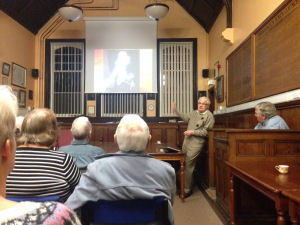 The audience, of another very well attended evening, heard David Rumbelow give an entertaining talk on a very odd invasion of Scarbrough in 1557 by Thomas Stafford and his followers. He was involved in two rebellions, the first led by Thomas Wyatt against Queen Mary after concern over her intention to marry Phillip II of Spain. The rebellion failed and Thomas Statfford fled to France. Stafford took two ships from Dieppe to Scarborough with over 30 men and took over the castle.The Earl of Westmorland recaptured the castle and Stafford and his men were captured and he was beheaded on Tower Hill along with 32 of his followers. |
| |
| Short Talks Evening |
| 21st January 2016 |
|
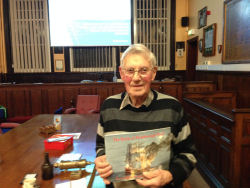 The Battle of Flamborough Head and the search for the wreck of the "Bonhomme Richard" The Battle of Flamborough Head and the search for the wreck of the "Bonhomme Richard" by Denis Moor. Denis was assisted by Jo Green to tell the story of the Battle of Flamborough head that took place in 1779. A fierce sea battle took place between the French warship the Bonhomme Richard commanded by the colourful character Jean Paul Jones fighting the British fleet as part of the American War of Independence. HMS Serapis was taken and boarded by the crew of Paul Jones and following the fierce sea battle of cannons firing at close quarters, the Bonhomme Richard sunk, off the coast of Flamborough Head, after their crew had already taken possession of HMS Serapis. Denis was a keen deep sea diver in the York sub aqua club and in the 1960's was called to look at some wreckage found in fishing nets. It could not be positively identified but on the night Denis brought pieces of wreckage including an old bilge pump. A fascinating talk from a living Pocklington legend of 86 years of age!
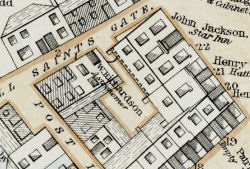 The Astronomers of the Pocklington area The Astronomers of the Pocklington area by Andrew Sefton. In the early nineteenth century, Pocklington and the local villages of Allerthorpe, Bielby and Seaton Ross produced contemporary astronomers, mathematicians, sundial makers and opticians and telescope makers. Using the journals of William Watson, Andrew speculated that they all used to meet at the house of William Watson in Seaton Ross where he had an observatory. Thomas Cooke made lenses and founded a large business in York making telescopes and navigation instruments. His younger brother Barnard founded an optical instruments shop in Hull still operating today. John Smith from Bielby was a sundial maker who finished his days in Stockton in the North East. William Rogerson and William Richardson from Pocklington became assistants to the Astronomer Royal in Greenwich, London. As a coincidence, the speaker mentioned he was also a founder member of the York Astronomical Society which started in 1972.
|
| |
|
| Past News Stories |
| |
| News Stories from 2015 |
| |
| News Stories from 2014 |
| |
| News Stories from 2013 |
| |
| News Stories from 2012 |
| |
| News Stories from 2011 |
| |
| News Stories from 2010 |
| |
| News Stories from 2009 |
| |
| News Stories from 2008 |
| |
| News Stories from 2007 |
| |
| |
|
|
|

